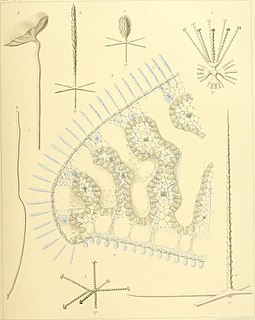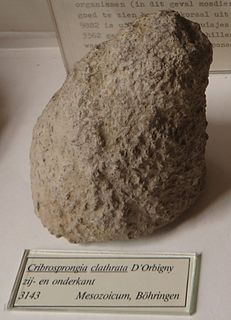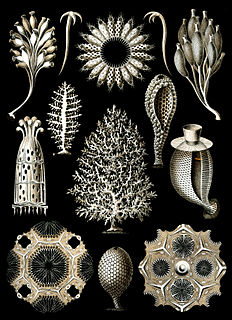
Sponges, the members of the phylum Porifera, are a basal animal clade as a sister of the Diploblasts. They are multicellular organisms that have bodies full of pores and channels allowing water to circulate through them, consisting of jelly-like mesohyl sandwiched between two thin layers of cells. The branch of zoology that studies sponges is known as spongiology.

The crimson rosella is a parrot native to eastern and south eastern Australia which has been introduced to New Zealand and Norfolk Island. It is commonly found in, but not restricted to, mountain forests and gardens. The species as it now stands has subsumed two former separate species, the yellow rosella and the Adelaide rosella. Molecular studies show one of the three red-coloured races, P. e. nigrescens, is genetically more distinct.

Rosellas are in a genus that consists of six species and nineteen subspecies. These colourful parrots from Australia are in the genus Platycercus. Platycercus means "broad-tailed" or "flat-tailed", reflecting a feature common to the rosellas and other members of the broad-tailed parrot tribe. Their diet is mainly seeds and fruit.

Banksia elegans, commonly known as the elegant banksia, is a species of woody shrub that is endemic to a relatively small area of Western Australia. Reaching 4 m (13 ft) high, it is a suckering shrub that rarely reproduces by seed. The round to oval yellow flower spikes appear in spring and summer. Swiss botanist Carl Meissner described Banksia elegans in 1856. It is most closely related to the three species in the subgenus Isostylis.

Banksia ser. Cyrtostylis is a taxonomic series within the plant genus Banksia. First published at sectional rank by George Bentham in 1870, it was demoted to a series by Alex George in 1981. The name has had three circumscriptions.

Sagartia elegans, the elegant anemone, is a species of sea anemone in the family Sagartiidae. It is found in coastal areas of northwest Europe at depths down to 50 metres.

The wildlife of Antarctica are extremophiles, having to adapt to the dryness, low temperatures, and high exposure common in Antarctica. The extreme weather of the interior contrasts to the relatively mild conditions on the Antarctic Peninsula and the subantarctic islands, which have warmer temperatures and more liquid water. Much of the ocean around the mainland is covered by sea ice. The oceans themselves are a more stable environment for life, both in the water column and on the seabed.
Tedania wellsae is a species of sea sponge first found on the coast of South Georgia island, in the south west Southern Ocean.
Caulospongia elegans is a species of sea sponge belonging to the family Suberitidae. It is found in Australia.
Craniella elegans is a species of marine sponges in the family Tetillidae. The type locality is between southern India and Sri Lanka.
Corbitella elegans is a species of glass sponges (Hexactinellids) belonging to the family Euplectellidae. It is found in the Banda Sea in the Maluku Islands of Indonesia.

Caulophacus elegans is a species of glass sponges belonging to the subfamily Lanuginellinae. The type specimen has been found in Central Kuroshio Current, near Japan.
Clathria elegans is a species of sea sponge in the family Microcionidae. It is found in the United States part of the North Atlantic Ocean. It was first described in 1880 by Gualtherus Carel Jacob Vosmaer.
Dactylia elegans is a species of demosponges in the family Callyspongiidae. It is found in Western Australia.

Cribrospongia is an extinct genus of prehistoric sponges in the family Cribrospongiidae. The species C. elegans is from the Jurassic period and has been found in Germany.

Sycon elegans is a species of calcareous sponges belonging to the family Sycettidae.
Leiosella is a genus of sponges belonging to the family Spongiidae.
Holopsamma is a genus of sponges belonging to the family Microcionidae.








